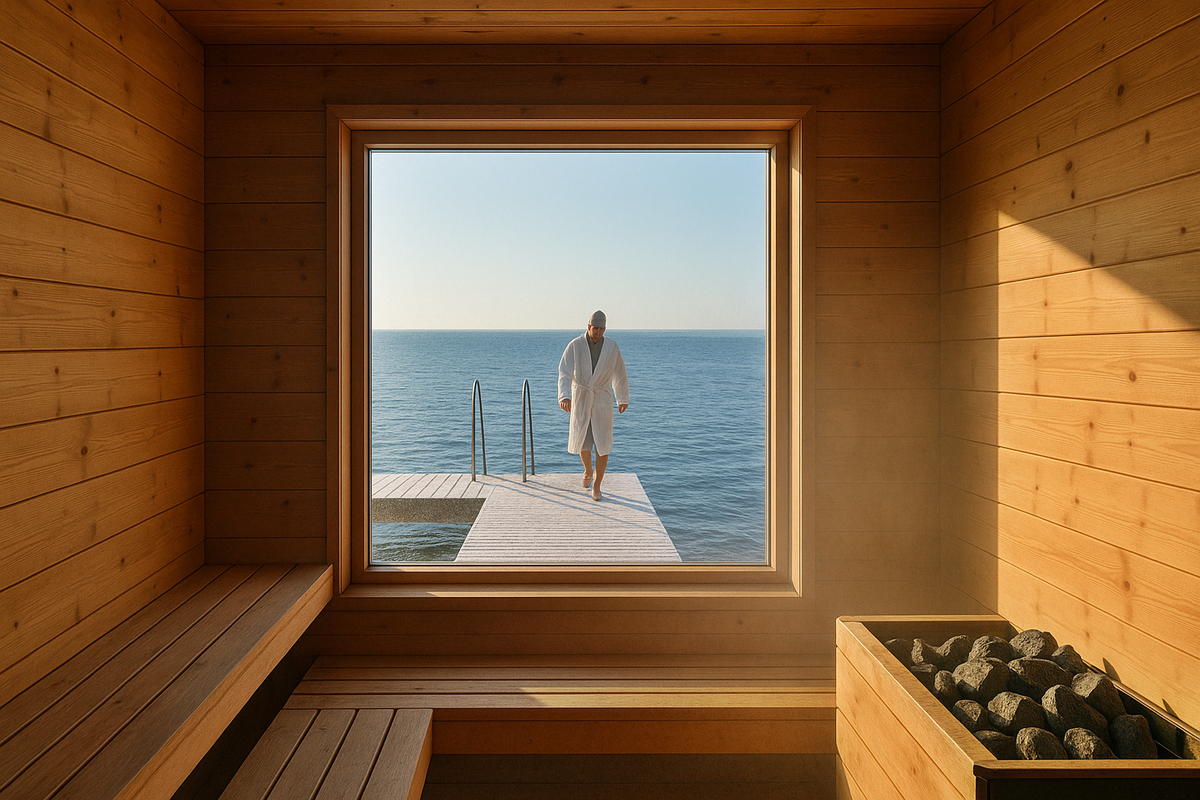🧊 Winter swimming and saunas by the water: where to try it safely between holidays
❄️ Winter swimming in Denmark (vinterbadning) has long gone beyond the realm of a ‘hobby for weirdos’ and has become part of urban culture: clubs at seaside bathing establishments, queues for membership, saunas by the water and whole groups meeting by the sea before work. For tourists, it is a powerful, memorable experience between the Christmas lights and the January sales — but only if you approach it consciously.
🧠 The goal is not to ‘conquer yourself’ for the sake of a photo, but to carefully fit one or two vinterbadning sessions into a 3-day itinerary and get out of the water on your own two feet, not on adrenaline. This article provides a basic safety framework, understandable ‘sauna + sea’ formats for beginners, a checklist of equipment, and ideas on how to logically fit this into a winter trip to Denmark.
⚕️ Important: this text is for informational purposes only and does not replace medical advice, especially if you have heart, blood pressure or respiratory problems.
🧊 What is vinterbadning in Danish and basic safety rules

Classic Danish vinterbadning involves several short dips in cold water (usually 20-60 seconds for beginners, slightly longer for experienced swimmers) with mandatory warming up in a warm room or sauna. Many Danes do this regularly throughout the winter, not just once ‘for the sake of it’.
The key principle is control and predictability, not heroism. You know in advance where you will enter the water, how you will get out, and where you will go to warm up.
⚠️ Basic safety rules
- 🚫 Do not swim alone. Always have at least two adults who can help each other.
- 👀 Assess the entry and exit points. Stairs, railings, no strong currents or waves, no ice at the water's edge.
- 🚶♂️ Enter the water gradually. Do not jump from a running start or dive headfirst — this is a direct risk of cold shock and uncontrolled inhalation of water.
- ⏱️ Short visits. For the first time, this means seconds, not minutes; it is better to get out of the water a little earlier than later.
- 🔥 After the sauna — a pause. Do not enter the icy water immediately after a very hot sauna: give your body 1–2 minutes to cool down and breathe calmly.
- 🍷 No alcohol. Alcohol reduces control, alters the sensation of cold and increases risks — winter swimming ‘after champagne’ is simply out of the question.
🚑 Who should definitely be especially careful
- people with cardiovascular diseases and uncontrolled blood pressure;
- those who have experienced fainting, serious arrhythmias, or recent surgery;
- pregnant women;
- children — only under the responsible supervision of adults and in formats that specifically provide for the participation of children.
When in doubt, the basic recommendation is simple: first discuss it with your doctor, then plan your swim.
🌉 Where to try it: clubs, harbour baths and ‘guest’ formats

For a beginner spending 2-3 days in Denmark, it is not club membership that is important, but a clear one-time experience: a booked slot in a sauna by the water, an open harbour bath with good infrastructure, clear rules and the opportunity to warm up quickly.
🏙️ Copenhagen: harbour and sea
There are several models operating in the capital:
- 🌁 Urban harbour baths and organised winter areas: footbridges, stairs, fences, sometimes separate mobile saunas.
- 🔥 Floating and stationary saunas in the harbour. As a rule, they are booked for a specific slot (60-120 minutes) for a small group; the combination of ‘sauna + access to the harbour stairs’ is already built into the product.
- 🌊 Sea baths near beaches. Popular city beaches may have winter swimming clubs with their own rules and separate access for members; it is easier for beginners to go to formats with open hours or commercial slots.
For a short trip, the logic is simple: choose a place where the sauna and access to the water are physically close and everything is already organised, rather than looking for a random pier.
🌆 Aarhus: bathing spots near the forest and club culture
Aarhus is one of the centres of Danish vinterbadning:
- 🏖️ In winter, clubs often have priority at city bathing spots (membership, their own keys, their own rules).
- 👥 The format for guests is either an invitation from a club member or open slots/commercial saunas on the shore with access to water.
The advantage of Aarhus is the combination of forest, water and city: a morning trip to the bathing area, several visits, followed by a hot drink and a return to the centre to visit museums.
🌊 West coast and regions
On the North Sea and in the fjords, the following are becoming increasingly common:
- mobile saunas on beaches with a pre-announced schedule;
- organised ‘winter weekends’ with ‘accommodation + sauna + swimming’ packages.
This is already a thing for those who initially plan their route around the coast, rather than just flying into the capital.
♨️ The ‘sauna by the water + swimming’ combo: what a session looks like

🔄 A typical cycle for a beginner
- Warm-up. 10–15 minutes in the sauna, without trying to ‘hold out for as long as possible’, with normal, unhurried breathing.
- Pause. Leave the sauna, stand quietly in the air for 1–2 minutes, let your pulse slow down a little.
- Enter the water. Slowly descend the stairs, holding onto the railing; breathe evenly, do not hold your breath; stay in the water for a few tens of seconds and get out before your body ‘goes numb’.
- Return to warmth. Quickly dry yourself off, put on a hat, dry socks, a warm layer of clothing, and return to the sauna or a warm room.
- Repeat. If you wish, repeat the cycle 2-3 times, but without feeling pressured to do so.
For your first session, one or two rounds are enough to get a feel for the experience and not overload your body.
🤝 Etiquette and rules on site
- 🧼 Cleanliness. Showering before the sauna and bathing is almost always a mandatory rule.
- 🧺 Silence and respect. Keep conversations low-key and respect the personal space of other guests.
- 🩱 Dress code.
- Clubs often have rules about nudity (no swimsuits) in the sauna;
- Swimsuits are more often allowed in commercial formats;
- In any case, read the dress code in advance so you won't be surprised at the entrance.
- 🚫 No alcohol and ‘tests of courage’. Staff may refuse admission if a guest appears intoxicated or inappropriately behaved.
🎒 Equipment and checklist: what to bring

Even a well-organised bathing facility cannot compensate for improperly prepared items. We work on the principle of warming up quickly, changing quickly, and not letting anything extra freeze.
🧷 Basic set for winter bathing
| 🧾 What to pack | 💡 Why you need it |
|---|---|
| 🩱 Swimsuit / swim trunks | If the format does not imply nudity in the sauna |
| 🧺 Large towel | To dry off quickly and cover your shoulders |
| 🧥 Warm robe / poncho | To wrap up between dips and protect from the wind |
| 🧢 Hat | You lose a lot of heat through your head, especially after being in the water |
| 🧦 Warm socks | To put on immediately after getting out so your feet don’t get cold |
| 🩴 Flip-flops / water shoes | So you don’t stand barefoot on cold decking or wet wood |
| ☕ Thermos with a drink | Hot tea or cocoa for gentle warmth from the inside |
| 👕 Dry underwear | To change completely after the last dip |
| 🎒 Small backpack/bag | To keep everything organised and not lose things in the wind |
In addition, many people use special vinterbade robes (thick, with hoods), which are convenient for changing clothes outside and warming up between dips.
🚫 What is best to avoid
- heavy cotton items that take a long time to dry and get cold if they get wet;
- jewellery and watches, which can get lost or feel unpleasant on the skin when cold;
- alcohol ‘for courage’ — this is a separate risk, not a help.
📅 How to fit vinterbadning into a 3-day itinerary

Winter swimming is not the whole trip, but one powerful highlight within the programme for 2-3 days. It is important to fit it in so that neither logistics nor well-being suffer.
🕒 Optimal time slots
- 🧊 The morning of the second day.
- You have already adapted to the city and slept off your flight.
- You have the rest of the day if you want to just relax and have a coffee after swimming.
- 🌤️ Daytime.
- For your first experience, it is better to choose daytime hours with normal visibility rather than ‘playing the hero in the dark and wind’.
🗺️ Example itinerary for Copenhagen
- Morning: breakfast closer to the harbour, then a booked slot for ‘sauna + swimming’.
- Day: lunch in a neighbouring area, a leisurely walk or a nearby museum.
- Evening: dinner, Christmas lights/winter lights, without any additional ‘feats’.
🗺️ Example itinerary for Aarhus
- Morning: trip to the bathing area by the water, 1–2 rounds of ‘sauna + sea’ followed by a hot drink.
- Day: return to the centre, museum block (ARoS or Den Gamle By), late lunch.
- Evening: café, hygge at the hotel, early night — no travelling to another city.
The main principle: after winter swimming — only gentle activities, no ‘museum rush’ and certainly no tight connections with trains and planes.
✅ Quick safety checklist before your first vinterbadning

Before booking a sauna and putting your idea into action, it makes sense to go through a quick checklist.
- 🩺 Health: do you have any serious heart, blood pressure or breathing problems? If in doubt, see your doctor first.
- 👥 Company: go with at least one other person; beginners should not bathe alone, even at an organised site.
- 🌊 Location: is there a convenient entrance/exit, stairs, railings, and are the wind and waves not too strong on the chosen day?
- ♨️ Warm plan B: is there a sauna/warm room or at least a guaranteed warm café/hotel nearby?
- 🎒 Equipment: is everything packed — swimsuit (if needed), large towel, hat, warm socks, flip-flops, dry clothes, thermos.
- ⏱️ Route: are there any tight connections with trains, buses or planes immediately after swimming?
- 🚫 Alcohol: winter swimming and alcohol are incompatible; if you are planning a festive evening, schedule your swim for another time.
🎯 If you can honestly answer ‘yes, it's under control’ to each point, vinterbadning in Denmark becomes not a dangerous challenge, but a well-planned part of your winter itinerary — with lights, hot drinks and the very lively sensation of northern water.
❓FAQ
✅ Yes, they can, but only at organised sites or in ‘sauna + sea’ formats, observing basic safety rules and without attempting to be a ‘hero’.
✅ For the first time, a few tens of seconds is enough. The main thing is to get out of the water before you start to feel severe chills and numbness.
✅ No, you can swim without a sauna, but the combination of ‘sauna by the water + a short dip’ makes the experience gentler and easier for a beginner.
✅ You will need a swimsuit (if it is not nude), a large towel or bathrobe, a hat, warm socks, slippers, dry clothes and a thermos with a hot drink.
✅ No, winter swimming alone is considered unsafe, so a minimum of two adults is a prerequisite.





0 comments
Log in to leave a comment